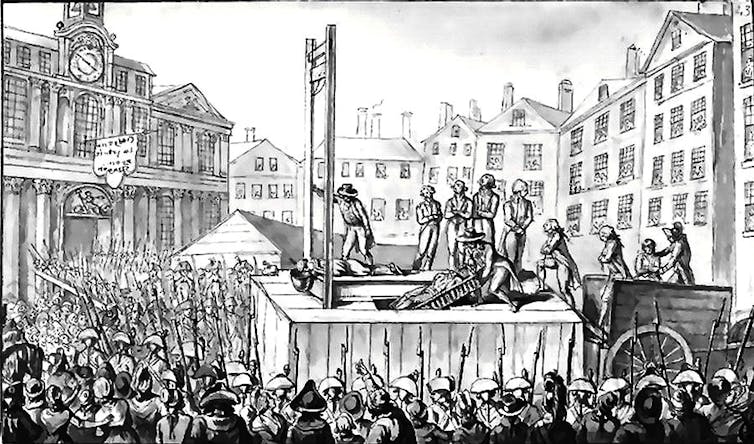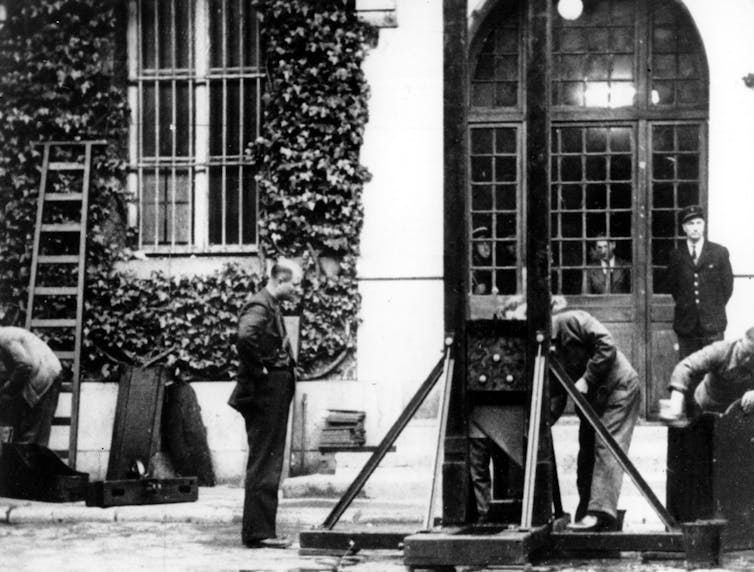
Experts in autocracies have pointed out that it is, unfortunately, easy to slip into normalizing the tyrant, hence it is important to hang on to outrage. These incidents which seem to call for the efforts of the Greek Furies (Erinyes) to come and deal with them will, I hope, help with that. As a reminder, though no one really knows how many there were supposed to be, the three names we have are Alecto, Megaera, and Tisiphone. These roughly translate as “unceasing,” “grudging,” and “vengeful destruction.”
I came across this article which addresses the “cruel” in “cruel and unusual punishment” as regards the death penalty Of course we all realize there are certainly many more objections to the death penalty than simply its cruelty. However, many challenges to that penalty, or even just the the way it is being administered, are founded on our Constitutional (Eighth Amendment) prohibition of cruelty. And I thought the article had an interesting take on the subject.
==================================================================
Why the guillotine may be less cruel than execution by slow poisoning

AlexLMX/Shutterstock
Janine Lanza, Wayne State University
Concerns about the drugs used for executions are being raised again after the federal government announced it will once again execute inmates convicted of capital crimes almost 16 years after the last execution was carried out.
International drug companies will no longer sell drugs for use in lethal injections in the United States. But Attorney General William Barr has authorized the federal justice system to use the widely available drug pentobarbital, despite concerns about whether that method violates the Eighth Amendment, which prohibits cruel and unusual punishment. In common use, the drug controls seizures in humans and is often used to euthanize pets.
In 2014, several executions carried out by states with untested methods using a mixture of drugs caused suffering and took hours to end prisoners’ lives.

AP/File photo
Among them was the botched execution of Oklahoma inmate Clayton Lockett, who thrashed around in pain for 43 minutes before dying, prompted President Obama to call for a moratorium on the death penalty for federal inmates.
While the death penalty is the ultimate punishment meted out by the state, it is not meant to be torture.
From the stake to the rope to the firing squad to the electric chair to the gas chamber and, finally, to the lethal injection, over the centuries the methods of execution in the United States have evolved to make execution quicker, quieter and less painful, both physically and psychologically.
It wasn’t always so. And there are, perhaps, lessons in history that could provide an answer to current concerns about the unusual cruelty of execution methods in the U.S.
Spectacles of physical torment
Under the French monarchy in the 17th and 18th centuries, execution was meant to be painful. That would purify the soul of the condemned before his final judgment, deter others from committing crime, and showcase the power of the king to impose unbearable suffering on his subjects.
Public executions were spectacles that were part public holiday, part grim warning. Crowds gathered to watch the prisoner endure physical torments almost too dreadful to imagine: hot pokers, boiling lead poured into wounds, dismembering hooks, and of course, the horses readied to draw and quarter.
Not everybody suffered so terribly, however. This parade of horrors was the fate of commoners. For nobles, a quick, relatively painless, and more dignified beheading replaced an hours-long public display.
One of the many goals of the French Revolution, which took place from 1789 to 1815, was to level society, to take away the privileges of the nobility, who lorded over commoners.

La Guillotine en 1793 by H. Fleischmann (1908), Wikimedia
Medium is the message
The solution to disparate forms of execution and social equality was first presented to the French National Assembly on Oct. 10, 1789 by Dr. Joseph Guillotin, who presented plans for a bladed machine to execute criminals.
It would be easy to use, work quickly and offer the same treatment to all condemned, regardless of social standing. His ideas finally became law in March 1791 and the guillotine was used for an execution the following year.
The so-called “national razor” took off the heads of the royal family as well as the humblest thief. It leveled bodies and society, with all citizens subject to the same punishment. And it ended the capricious torment of the condemned by the monarchy as well as the privilege that nobles had, even regarding the manner of their deaths.
The guillotine was a killing machine that provided not just a convenient method of execution but the proper political and ideological message for the Revolution.
Less cruel and unusual?
Eventually, the French Revolution became more politically radical, moving from a system where the king would continue to govern within a constitutional system to a republic where the people’s representatives would wield political power to a de facto dictatorship. As the Revolution became more radical, and politicians saw plots everywhere, increasing numbers of citizens were sentenced to death.
With the need to execute many prisoners the guillotine was pressed into greater use. The most careful estimate for the number of French executed during the Terror, the height of the radical Revolution, was 17,000. This number included almost exclusively those charged with political crimes.
It was the guillotine’s plummeting blade that took off head after head with just a bit of cleaning and sharpening in between, answering the need of the moment. Thus it came to symbolize state terrorism but also swift and equal justice.

AP
Terrifying – but brief
The guillotine remains a quick method of execution – it takes about half a second for the blade to drop and sever a prisoner’s head from his body.
While the moment of execution could be nothing but terrifying, that second of suffering was brief in comparison to the 43 minutes it took for Lockett to die after lethal drugs were administered.
In the same year, 2014, convicted double murderer Joseph Rudolph Wood of Arizona suffered for two hours before succumbing to the jerry-built drug cocktail dreamed up in a warden’s office. In 2018, an Alabama execution had to be halted after 12 attempts to place an IV line in Doyle Hamm failed.
The current technology of execution does not reliably provide the humane death demanded by the Constitution. In requiring an IV line and medical personnel to administer drugs it also involves medical practice with the death penalty.
Although the guillotine may be the bloodiest of deaths – the French used sand bags to soak up the blood – it does not cause the prolonged physical torment increasingly delivered by lethal injections.
Should the U.S. consider using the guillotine to administer capital punishment?
It has advantages – no secret recipes for lethal injections, no botched placement of IV needles, no conflation of medicine and execution.
While the guillotine provides a death that is not easy to witness, the death it delivers to the condemned is quick and does not cause the extended pain of bespoke lethal injections.
Could such a death, as bloody as it is, pass muster with the Eighth Amendment’s mandate against cruel and unusual punishment?![]()
Janine Lanza, Associate Professor of History, Wayne State University
This article is republished from The Conversation under a Creative Commons license. Read the original article.
==================================================================
Professor Lanza does not go into any detail about the background and intentions of Dr Joseph-Ignace Guillotin. Perhaps she didn’t feel that it was germane, and maybe it isn’t, but I am also  interested in persons from history who have reputations different who who they actually were. Sometimes the impression attached to them is unfairly unfavorable (Nero, Richard III, Marie Antoinette), sometimes it is unfairly favorable (Christopher Columbus), but unfair is unfair. Dr. Guillotin is associated in many minds with blood and death. It may surprise you to know that he was a lifelong opponent of capital punishment – or that he didn’t even invent the machine which bears his name. A medical doctor did work with the actual inventor (a fellow named Tobias Schmidt), but that doctor was not Dr. Guillotin. He did propose that such a machine be invented – “a machine that beheads painlessly.” He hoped that a more humane and less painful method of execution would be a first step toward complete abolition of the death penalty. If it did (and it may have done, as many nations today have prohibited it), it was a very small and slow step indeed. Totally unrelated, Dr. Guillotin was also one of the first physicians to support vaccination.
interested in persons from history who have reputations different who who they actually were. Sometimes the impression attached to them is unfairly unfavorable (Nero, Richard III, Marie Antoinette), sometimes it is unfairly favorable (Christopher Columbus), but unfair is unfair. Dr. Guillotin is associated in many minds with blood and death. It may surprise you to know that he was a lifelong opponent of capital punishment – or that he didn’t even invent the machine which bears his name. A medical doctor did work with the actual inventor (a fellow named Tobias Schmidt), but that doctor was not Dr. Guillotin. He did propose that such a machine be invented – “a machine that beheads painlessly.” He hoped that a more humane and less painful method of execution would be a first step toward complete abolition of the death penalty. If it did (and it may have done, as many nations today have prohibited it), it was a very small and slow step indeed. Totally unrelated, Dr. Guillotin was also one of the first physicians to support vaccination.
Would the guillotine be less painful for the person being executed than any other method of execution for which we have the technology? You bet. Will it ever be re-adopted, or adopted for the first time here? Of course not. Because the feelings of the condemned are far less important to the public than the feelings of the public. And executions by guillotine might make the public uncomfortable. Especially the Republican “pro-life” public. And we couldn’t have that.
Alecto, Megaera, and Tisiphone, it would be wonderful if you could arouse our collective conscience to abolish the death penalty once and for all. But I fear that even you cannot rouse a conscience in a person who has none.
The Furies and I will be back.
10 Responses to “Everyday Erinyes #188”
Sorry, the comment form is closed at this time.

What has prevailed in the states that abolished it is the combination that research has consistently shown that it does not have a deterrent effect on crime coupled with its expense being more than life in prison. Thus it is only the blood thirsty that continue to support it IMO. Thanks Joanne.
Also, if you can attend, seems deserving of a post:October 21, 2019 – February 2, 2020Denver Art Museum – Hamilton BuildingTicketed with member discountFor tickets, purchase online or call 720-913-0130.The Denver Art Museum will be home to the most comprehensive U.S. exhibition of Monet paintings in more than two decades. The exhibition will feature more than 120 paintings spanning Monet’s entire career and will focus on the celebrated French impressionist artist’s enduring relationship with nature and his response to the varied and distinct places in which he worked.https://denverartmuseum.org/exhibitions/claude-monet
Very interesting article, especially the unknown part – to me – about Dr Guillotin himself 😉. However, as far as I’m concerned the whole discussion on a less cruel way of execution is irrelevant. There should be no capital punishment, no executions, no state-sponsored murder, no drawn-out torture. States shouldn’t be given the space to discuss alternative ways of murdering people and trying to make watching it more humane for the onlookers. I know you and the Furies think that too, Joanne, so thanks for an interesting read.
Worth the read, and an excellent post.
I am against executions, state or otherwise, and the viewings of them. I find them abhorrent, and depressing to say the least. Hell, I have a hard time hearing hunters talking about their kills, let alone this.
I did not know that Dr.Guillotin was against capital punishment, and was also among the first of physicians to support vaccines.
Thanks, Joanne (and Furies).
A very interesting man. He also served on a committee, appointed by the King, with Ben Franklin (I gather when Ben was out ambassador there), and later sent into the Assembly (like our Congress) which is the context in which he proposed the guillotine.
Very interesting and informative post! Always good to learn new things – like not only was he NOT the inventor but he opposed capital punishment, but entirely unknown to me.
I oppose capital punishment for three main reasons:
[1] I don’t think we have that moral right
[2] There’s no correcting a mistake
[3] Cheaper to imprison someone for life than the legal costs of endless appeals that always occurs when someone is sentenced to death.
Maybe some of you are old enough to remember how the opening monologue of “Alfred Hitchcock Presents” would humorously (but also morbidly) poke fun at someone or some institution. Joanne’s wonderful post today reminded me of this one:
I would never have guessed it from his physique, but apparently Hitch knew how to exercise. 12
Yes, Dr.. Guillotin was quite a guy. Trump voters would have hated him (he was smart as a whip, except on human nature – those in favor of capital punishment, IMO, are unlikely to come around to opposing it through making it less torturous) but I think I would have liked him
Great piece JD!
First, any execution is, in my opinion, murder by the state. America needs to join the civilized nations of the world and abolish the practice.
That said, if I were to be executed, I would prefer the guillotine to any method in use in the US. I would want it nationally televised in close-up HD color!
We are, I expect, all in agreement here that it’s wrong and should go. And I think I see where you are going with that TV, color, up close and personal scenario. Someone (well, many people, but someone must have said it first) said that the essence of the Gospel is to comfort the afflicted and afflict the comfortable. And your scenario would afflict some of the comfortable. But there is a cadre of folks comfortable with capital punishment who would not be afflicted by it. Sadly.
I’d say the majority of Americans support the death penalty without really thinking about it. They are the comfortable I want to afflict.
I go one step further. The downside is that the Republican base would tune-in with beer and popcorn ready, so they could cheer.
Outstanding post. Very informative.
I also am one against capital punishment or any type of executions.
I kind of remember seeing “Alfred Hitchcock Presents”, when my parent had it on.
Thanks Joanne